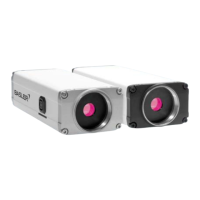AW00097209000 Real-Time Trigger Functionality
Basler IP Fixed Box Cameras 97
7 Real-Time Trigger
Functionality
7.1 Introduction
The camera normally captures images without the need for any type of triggering by the user. For
instance, if a camera is set for a frame rate of 30 frames (images) per second, it will internally
generate all of the required signals needed to initiate the start of an image capture every 1/30 of a
second. In this scenario, the user has no control over when the start of any image capture will occur.
The camera simply begins each image capture as required to maintain the frame rate.
In many typical surveillance situations, this mode of operation is exactly what the user wants. An
automatically captured, continuous stream of images will be perfect, for example, to monitor the
actions on a banking floor or a building lobby. In some situations, however, it would be desirable to
be able to trigger an image capture at a particular point in time. For example, in a traffic control
situation the user might want to trigger an image capture at a particular point in time after a car
passes a sensor on a highway.
The real-time trigger feature on the camera guarantees that an image capture will start (i.e., the
exposure of an image will start) after a trigger signal is applied to a properly configured I/O port on
the camera and an "abort time" period has expired. The abort time for all BIP2 box camera models
is seven milliseconds, so an image capture is guaranteed to start seven milliseconds after a real-
time trigger signal is applied to a properly configured port on the camera.
Figure 15 on page 98, illustrates the normal image capture process used by the camera. In
Figure 15, each yellow bar represents an image capture that is triggered by the camera’s internal
triggering process. The beginning of the yellow bar represents the point where the camera begins
the exposure for an image capture. The end of the bar represents the point where the camera has
finished reading the capture image data from the sensor and is ready to transmit the data out of the
camera. Because the camera is capturing images at a rate of 30 frames per second, the camera is
triggering the start of a new capture every 1/30 of a second. Since the camera is triggering these
captures internally, the user has no way of knowing exactly when any of the image captures will
start.
Figure 16 on page 98 illustrates how the real-time trigger feature works. When the user applies a
trigger signal to the camera, the camera immediately begins to abort any image captures that are
currently in progress. This abort process takes 7 milliseconds. At the end of the 7 milliseconds, the
camera begins a new image capture (i.e., it starts the exposure for a new image). When the capture
process for the real-time triggered image is complete, the image will be transmitted from the
camera. The user can be sure that the exposure for this image started exactly 7 milliseconds after
the real-time trigger signal was received by the camera.
At some point after the abort process ends, the camera will revert to its normal internal method of
triggering the start of image capture. In the case of this example, this will happen 1/30 of a second
after the end of the abort because the camera is operated at 30 frames per second.

